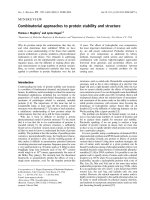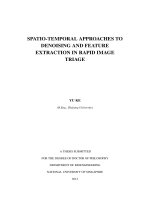Some approaches to nonlinear modelling and prediction
Bạn đang xem bản rút gọn của tài liệu. Xem và tải ngay bản đầy đủ của tài liệu tại đây (1.16 MB, 163 trang )
SOME APPROACHES TO NONLINEAR
MODELING AND PREDICTION
WANG TIANHAO
NATIONAL UNIVERSITY OF SINGAPORE
2013
SOME APPROACHES TO NONLINEAR
MODELING AND PREDICTION
WANG TIANHAO
(B.Sc. East China Normal University)
A THESIS SUBMITTED
FOR THE DEGREE OF DOCTOR OF PHILOSOPHY
DEPARTMENT OF STATISTICS AND APPLIED
PROBABILITY
NATIONAL UNIVERSITY OF SINGAPORE
2013
iii
ACKNOWLEDGEMENTS
I would like to give my sincere thanks to my PhD supervisor, Professor Xia
Yingcun. It has been an honor to be one of his students. He has taught me,
both consciously and unconsciously, how a useful statistical model could be built
and applied to the real world. I appreciate all his contributions of time, ideas,
and funding to make my PhD experience productive and stimulating. This thesis
would not have been possible without his active support and valuable comments.
I would also like to gratefully thank other faculty members and support staffs of
the Department of Statistics and Applied Probability for teaching me and helping
me in various ways throughout my PhD candidacy.
Last but not the least, I would like to thank my family for all their love and
encouragement. For my parents who raised me with a love of science and supported
iv Acknowledgements
me in all my pursuits. And most of all for my loving, supportive, encouraging, and
patient wife, Chen Jie, whose faithful support during the final stages of this PhD
is so appreciated. Thank you.
v
MANUSCRIPTS
Wang, T. and Xia, Y. (2013) A piecewise single-index mo del for dimension re-
duction. To appear in Technometrics.
Wang, T. and Xia, Y. (2013) Whittle likelihood estimation of nonlinear autore-
gressive models with moving average errors. Submitted to Biometrika.
vii
CONTENTS
Acknowledgements iii
Manuscripts v
Summary xi
List of Tables xiii
List of Figures xv
Chapter 1 A Piecewise SIM for Dimension Reduction 1
1.1 Introduction . . . . . . . . . . . . . . . . . . . . . . . . . . . . . . . 1
1.1.1 Effective Dimension Reduction (EDR) Space . . . . . . . . . 2
1.1.2 Single-Index Model (SIM) . . . . . . . . . . . . . . . . . . . 5
viii CONTENTS
1.1.3 Piecewise Regression Models . . . . . . . . . . . . . . . . . . 6
1.1.4 Piecewise Single-Index Model (pSIM) . . . . . . . . . . . . . 8
1.2 Estimation of pSIM . . . . . . . . . . . . . . . . . . . . . . . . . . . 11
1.2.1 Model Estimation . . . . . . . . . . . . . . . . . . . . . . . . 12
1.2.2 Selection Of Tuning Parameters . . . . . . . . . . . . . . . . 16
1.3 Simulations . . . . . . . . . . . . . . . . . . . . . . . . . . . . . . . 18
1.4 Real Data Analysis . . . . . . . . . . . . . . . . . . . . . . . . . . . 28
1.5 Asymptotic Analysis . . . . . . . . . . . . . . . . . . . . . . . . . . 43
1.6 Proofs . . . . . . . . . . . . . . . . . . . . . . . . . . . . . . . . . . 48
Chapter 2 WLE of Nonlinear AR Models with MA Errors 71
2.1 Time Series Analysis: A Literature Review . . . . . . . . . . . . . . 71
2.1.1 Stationarity of Time Series . . . . . . . . . . . . . . . . . . . 72
2.1.2 Linear Time Series Models . . . . . . . . . . . . . . . . . . . 73
2.1.3 Nonlinear Time Series Models . . . . . . . . . . . . . . . . . 75
2.1.4 Spectral Analysis and Periodogram . . . . . . . . . . . . . . 77
2.1.5 Whittle Likelihood Estimation (WLE) . . . . . . . . . . . . 79
2.2 Introduction of the Extended WLE (XWLE) . . . . . . . . . . . . . 81
2.3 Estimating Nonlinear Models with XWLE . . . . . . . . . . . . . . 84
2.4 Model Diagnosis Based on XWLE . . . . . . . . . . . . . . . . . . . 87
2.5 Numerical Studies . . . . . . . . . . . . . . . . . . . . . . . . . . . . 90
2.6 Asymptotics of XWLE . . . . . . . . . . . . . . . . . . . . . . . . . 113
Chapter 3 Conclusion and Future Works 133
CONTENTS ix
Bibliography 137
xi
SUMMARY
Our work in this thesis consists of two parts. The first part (Chapter 1) deals
with dimension reduction in nonparametric regressions. In this Chapter we propose
to use different single-index models for observations in different regions of the
sample space. This approach inherits the estimation efficiency of the single-index
model in each region, and at the same time allows the global model to have multi-
dimensionality in the sense of conventional dimension reduction (Li, 1991). On the
other hand, the model can be seen as an extension of CART (Breiman et al, 1984)
and a piecewise linear model proposed by Li et al (2000). Modeling procedures,
including identifying the region for every single-index model and estimation of the
single-index models, are developed. Simulation studies and real data analysis are
employed to demonstrate the usefulness of the approach.
xii Summary
The second part (Chapter 2) deals with nonlinear time series analysis. In this
Chapter, we modify the Whittle likelihood estimation (WLE; Whittle, 1953) such
that it is applicable to models in which the theoretical spectral density functions of
the models are only partially available. In particular, our modified WLE can be ap-
plied to most nonlinear regressive or autoregressive models with residuals following
a moving average process. Asymptotic properties of the estimators are established.
Its p erformance is checked by simulated examples and real data examples, and is
compared with some existing methods.
xiii
List of Tables
Table 1.1 Simulation results of Example 1.3.1: mean of in-sample (IS)
and out-of-sample (OS) prediction errors (ASE) from the 100 repli-
cations. The percentage numbers in the parenthesis are the pro-
portion of times that the number of regions (m) of the model is
identified as three by the proposed BIC metho d. . . . . . . . . . . . 23
Table 1.2 Simulation results of Example 1.3.2: mean of in-sample (IS)
and out-of-sample (OS) prediction errors (ASE) (×10
−3
) from the
100 replications. . . . . . . . . . . . . . . . . . . . . . . . . . . . . . 25
xiv List of Tables
Table 1.3 Simulation results of Example 1.3.2 (continued): mean of in-
sample (IS) and out-of-sample (OS) prediction errors (ASE) (×10
−3
)
from the 100 replications. . . . . . . . . . . . . . . . . . . . . . . . 26
Table 1.4 BIC scores for the hitters’ salary data (with the outliers re-
moved) . . . . . . . . . . . . . . . . . . . . . . . . . . . . . . . . . . 30
Table 1.5 Simulation results of the hitters’ salary data: mean of in-
sample (IS) and out-of-sample (OS) prediction errors (ASE) from
the 100 replications. . . . . . . . . . . . . . . . . . . . . . . . . . . 33
Table 1.6 BIC scores for the LA Ozone data . . . . . . . . . . . . . . . 35
Table 1.7 Simulation results of the LA ozone data: mean of in-sample
(IS) and out-of-sample (OS) prediction errors (ASE) from the 100
replications. . . . . . . . . . . . . . . . . . . . . . . . . . . . . . . . 38
Table 1.8 BIC scores for the cars data . . . . . . . . . . . . . . . . . . 39
Table 1.9 Simulation results of the cars data: mean of in-sample (IS)
and out-of-sample (OS) prediction errors (ASE) from the 100 repli-
cations. . . . . . . . . . . . . . . . . . . . . . . . . . . . . . . . . . 43
Table 2.1 Simulation results for Example 2.5.2. . . . . . . . . . . . . . 103
List of Tables xv
Table 2.2 BIC
W
scores for the Ni˜no 3.4 SST anomaly data . . . . . . . 111
xvii
List of Figures
Figure 1.1 A typical estimation result of Example 1.3.1 with sample size
n = 400. . . . . . . . . . . . . . . . . . . . . . . . . . . . . . . . . 21
Figure 1.2 The estimation errors of the three piecewise single-index D
2
(
ˆ
β
i
, β
i
),
i = 1, 2, 3 in Example 1.3.1. . . . . . . . . . . . . . . . . . . . . . . 22
Figure 1.3 Four typical estimation results of Example 1.3.2. . . . . . . 27
Figure 1.4 y plotted against β
⊤
0
x for the hitters’ salary data. . . . . . . 29
Figure 1.5 Fitting results for the hitter’s salary data. . . . . . . . . . . . 31
xviii List of Figures
Figure 1.6 The maximum a posteriori (MAP) tree at height 3 estimated
by TGP-SIM for the hitters’ salary data. . . . . . . . . . . . . . . . 34
Figure 1.7 Fitting results for the LA ozone data. . . . . . . . . . . . . . 36
Figure 1.8 The maximum a posteriori (MAP) tree at height 2 estimated
by TGP-SIM for the LA ozone data. . . . . . . . . . . . . . . . . . 37
Figure 1.9 Fitting results for the cars data. . . . . . . . . . . . . . . . . 41
Figure 1.10 The tree structures estimated by the TGP-SIM model for the
cars data. . . . . . . . . . . . . . . . . . . . . . . . . . . . . . . . . 42
Figure 2.1 Simulation results for ARMA(1, 1) models with ε
t
∼ N(0, 1),
where y-axes represent log(Err) and x-axes represent θ
1
; blue ‘o’:
WLE, green ‘’: MLE, red ‘∗’: XWLE. . . . . . . . . . . . . . . . . 93
Figure 2.2 Simulation results for ARMA(2, 1) models with ε
t
∼ N(0, 1),
where y-axes represent log(Err) and x-axes represent θ
1
; blue ‘o’:
WLE, green ‘’: MLE, red ‘∗’: XWLE. . . . . . . . . . . . . . . . . 94
Figure 2.3 Simulation results for ARMA(5, 1) models with ε
t
∼ N(0, 1),
where y-axes represent log(Err) and x-axes represent θ
1
; blue ‘o’:
WLE, green ‘’: MLE, red ‘∗’: XWLE. . . . . . . . . . . . . . . . . 95
List of Figures xix
Figure 2.4 Simulation results for ARMA(1, 1) models with ε
t
∼ t(1),
where y-axes represent log(Err) and x-axes represent θ
1
; blue ‘o’:
WLE, green ‘’: MLE, red ‘∗’: XWLE. . . . . . . . . . . . . . . . . 96
Figure 2.5 Simulation results for ARMA(2, 1) models with ε
t
∼ t(1),
where y-axes represent log(Err) and x-axes represent θ
1
; blue ‘o’:
WLE, green ‘’: MLE, red ‘∗’: XWLE. . . . . . . . . . . . . . . . . 97
Figure 2.6 Simulation results for ARMA(5, 1) models with ε
t
∼ t(1),
where y-axes represent log(Err) and x-axes represent θ
1
; blue ‘o’:
WLE, green ‘’: MLE, red ‘∗’: XWLE. . . . . . . . . . . . . . . . . 98
Figure 2.7 Simulation results for ARMA(1, 1) models with ε
t
∼ U(−1, 1),
where y-axes represent log(Err) and x-axes represent θ
1
; blue ‘o’:
WLE, green ‘’: MLE, red ‘∗’: XWLE. . . . . . . . . . . . . . . . . 99
Figure 2.8 Simulation results for ARMA(2, 1) models with ε
t
∼ U(−1, 1),
where y-axes represent log(Err) and x-axes represent θ
1
; blue ‘o’:
WLE, green ‘’: MLE, red ‘∗’: XWLE. . . . . . . . . . . . . . . . . 100
Figure 2.9 Simulation results for ARMA(5, 1) models with ε
t
∼ U(−1, 1),
where y-axes represent log(Err) and x-axes represent θ
1
; blue ‘o’:
WLE, green ‘’: MLE, red ‘∗’: XWLE. . . . . . . . . . . . . . . . . 101
xx List of Figures
Figure 2.10 Rate of rejections for the LB(20)-tests and AN(20)-tests in
Example 2.5.2. . . . . . . . . . . . . . . . . . . . . . . . . . . . . . 104
Figure 2.11 Time plots for the transformed sunspot number. . . . . . . . 106
Figure 2.12 Root mean squred prediction errors of out-of-sample multi-
step forecasts for the original numbers of the sunspots. . . . . . . . 109
Figure 2.13 Time plots for the Ni˜no 3.4 anomaly. . . . . . . . . . . . . . 110
Figure 2.14 Root mean squred prediction errors of out-of-sample multi-
step forecasts for Ni˜no 3.4 SST anomaly data. . . . . . . . . . . . . 113
1
CHAPTER 1
A Piecewise SIM for Dimension
Reduction
1.1 Introduction
Exploring multivariate data under a nonparametric setting is an important
and challenging topic in many disciplines of research. Specifically, suppose y is the
response variable of interest and x = (x
1
, , x
p
)
⊤
is the p−dimensional covariate.
For a nonparametric regression model
y = ψ(x
1
, , x
p
) + ε, (1.1)
2 Chapter 1. A Piecewise SIM for Dimension Reduction
where ε is the error term with mean 0, the estimation of unknown multivariate
function ψ(x
1
, , x
p
) is difficult. There are several different ways to do the non-
parametric regression. The two most popular techniques are local polynomial ker-
nel smoothing and spline smoothing. But no matter which technique we use to do
the nonparametric regression, as the dimension increases, the estimation efficiency
drops dramatically, which is the so-called curse of dimensionality.
1.1.1 Effective Dimension Reduction (EDR) Space
Numerous approaches have been developed to tackle the problem of high di-
mensionality. One of the most popular approaches is searching for an effective
dimension reduction (EDR) space; see for example Li (1991) and Xia, Tong, Li
and Zhu (2002). The EDR space was first introduced by Li (1991) who proposed
the model
y =
˜
f(β
⊤
1
x, ··· , β
⊤
q
x, ε), (1.2)
where
˜
f is a real function on R
q+1
and ε is the random error independent of x. Our
primary interest is on the q p-dimensional column vectors β
1
, , β
q
. Of special
interest is the additive noise model
y = f(β
⊤
1
x, ··· , β
⊤
q
x) + ε. (1.3)
1.1 Introduction 3
where f is a real function on R
q
. Denote by B = (β
1
, ··· , β
q
) the p × q matrix
pooling all the vectors together. For identification concern, it is usually assumed
that B
⊤
B = I
q
, where I
q
denotes the q by q identity matrix. The space spanned
by B
⊤
x is called the EDR space, and the vectors β
1
, , β
q
are called the EDR
directions.
If we know the exact form of f(·), then (1.3) is not much different from a simple
neural network model, or a nonlinear regression model. However, (1.3) is special
in that f(·) is generally assumed to be unknown and we need to estimate both B
and f(·).
There are essentially two approaches to do the estimations. The first is the
inverse regression approach first proposed by Li (1991). In his sliced inverse re-
gression (SIR) algorithm, instead of regressing y on x, Li (1991) proposed to regress
each predictor in x against y. In this way, the original p-dimensional regression
problem is reduced to be multiple one-dimensional problems. The SIR method has
been proven to be powerful in searching for EDR directions and dimension reduc-
tion. However, the SIR method imposes some strong probabilistic structure on x.
Specifically, this method requires that, for any β ∈ R
p
, the conditional expectation
E(β
⊤
x|β
⊤
1
x, ··· , β
⊤
q
x)
is linear in β
⊤
1
x, ··· , β
⊤
q
x; i.e., there are constants c
0
, ··· , c
q
depending on β such
4 Chapter 1. A Piecewise SIM for Dimension Reduction
that
E(β
⊤
x|β
⊤
1
x, ··· , β
⊤
q
x) = c
0
+ c
1
β
⊤
1
x + ··· + c
q
β
⊤
q
x.
An important class of random variables that do not satisfy this assumption is the
lagged time series variable x := (y
t−1
, , y
t−p
) where {y
t
} is a time series.
The second approach of searching for the EDR directions is through direct
regression of y on x. One of the most popular methods in this category is the
minimum average variance estimation (MAVE) method introduced by Xia et al
(2002). In this method, the EDR directions are found by solving the optimization
problem
min
B
{E[y −E(y|B
T
x)]},
subject to B
⊤
B = I
q
, where E(y|B
T
x) is approximated by a local linear expansion.
Through direct regression, the condition on the probability structure of x can be
significantly relaxed. So as compared to the inverse-regression based approaches,
MAVE method is applicable to a much broadened scope of possible distributions of
x, including the nonlinear autoregressive modeling aforementioned which violates
the basic assumption of the inverse-regression based approaches.









